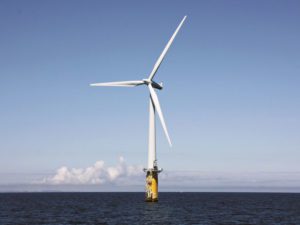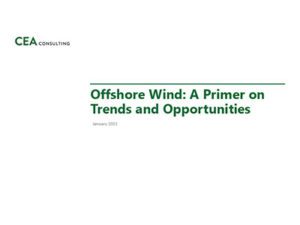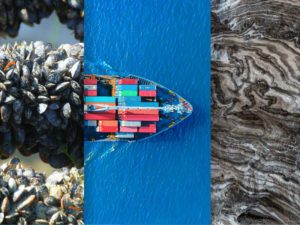The Biden administration recently announced its plan to double offshore wind by 2030. Our Shared Seas checked in with partners to discuss what it will take to meet this target and ways that marine funders and NGOs can support responsible development of the sector. In this interview, Laura Morton, Senior Director, Policy and Regulatory Affairs, Offshore at American Clean Power and Catherine Bowes, Program Director, Offshore Wind Energy at National Wildlife Federation share their perspectives from the field.
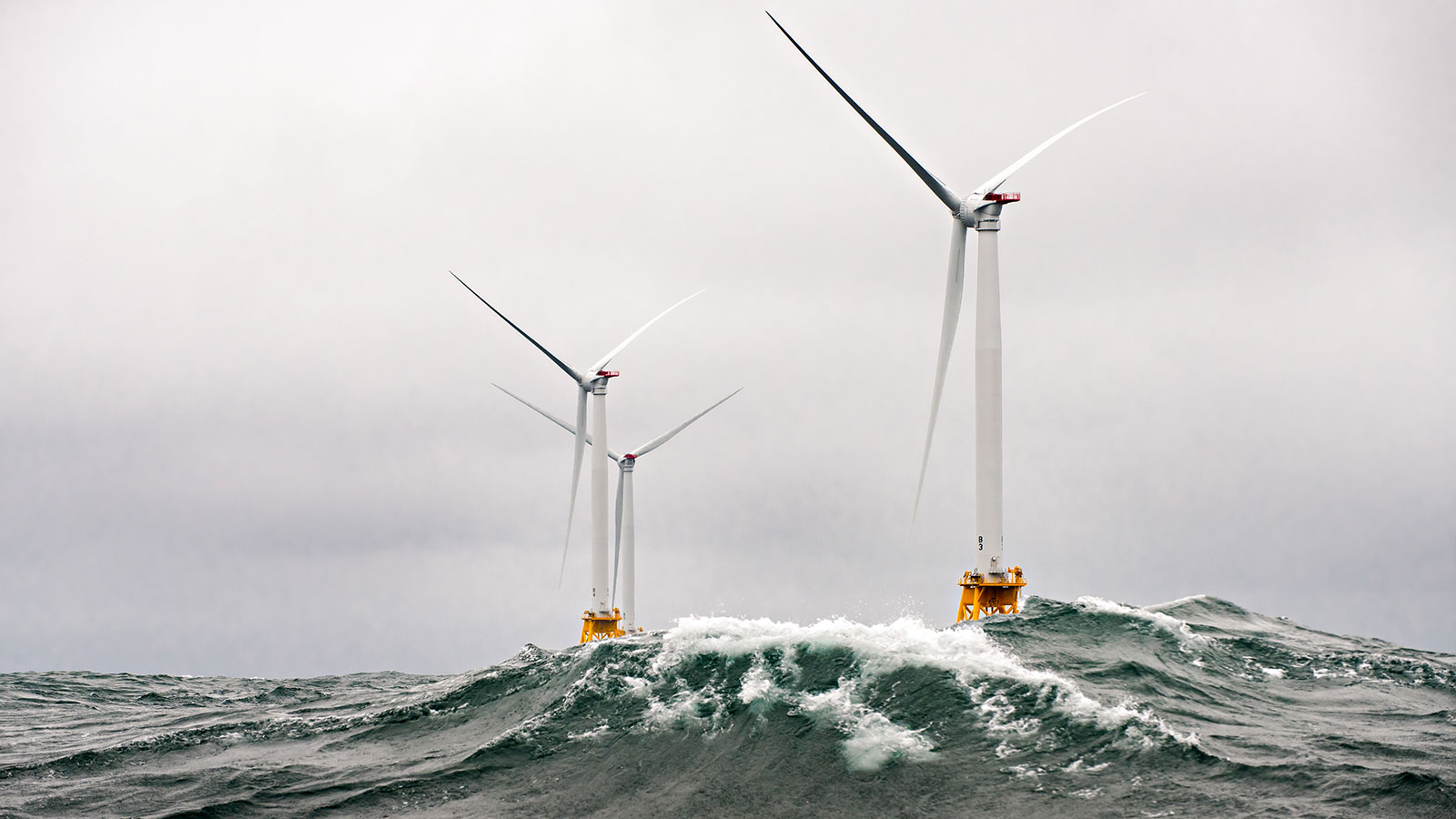
Block Island Wind Farm. Photo: Dennis Schroeder / NREL
It seems that the offshore wind sector is facing a sea change given the Biden administration’s recent announcement to deploy 30 gigawatts of offshore wind power by 2030. Can you unpack the state of play of how we’ve arrived here and what needs to happen next to meet this target?
Laura Morton, American Clean Power: We’ve been trying to get to this point since the Cape Wind project was proposed in 2001. There has been momentum over the years, but it has taken time for the industry to develop due to a variety of factors. As you know, offshore wind is a nascent industry in the U.S. It has faced delays due to regulatory uncertainty, the need to gain permits from a number of federal and states agencies, and litigation challenges over the years.
The Obama administration made great strides in moving forward with the creation of intergovernmental task forces, smart coordination across federal and state agencies, and issuance of the first leases following Cape Wind. Over the past decade, 15 leases have been issued after significant input from the public. In the last two years, however, this work took a pause as the Bureau of Ocean Energy Management (BOEM) requested a more comprehensive review of the environmental impacts of the first commercial-scale project.
Now, there is strong momentum with the Biden administration’s leadership on offshore wind. American Clean Power is very much in support of the offshore wind target of 30 gigawatts by 2030. It’s nice to see an administration that is committed to addressing climate change and recognizes that offshore wind is a key part of achieving its ambitious climate goals. The Administration’s commitment to government-wide approach to accelerating offshore wind deployment will also be very critical.
To reach our goals, we need a commitment to work across all federal agencies for efficient and effective permitting. We also need to recognize that the permitting and consulting agencies need more resources to do the job that they’ve been asked to do and to which they have committed. This includes not only construction and operation plans currently in progress, but also anticipated new lease sales. And we can’t forget along the way the importance of working with all other ocean users, including the maritime and commercial fishing industries, and of course with environmental organizations to ensure that we have responsibly developed and sustainable projects.
Federal officials have suggested that meeting the offshore wind target would create about 80,000 new jobs. Who would benefit from these jobs, and what would it look like to achieve a just transition in scaling up the offshore wind sector?
Laura Morton, American Clean Power: It’s important to recognize that offshore wind jobs and investments will have a significant economic impact, not just for coastal communities but also for communities across the country, including for those in the middle of the country, where manufacturing facilities are already developing parts for onshore turbines. For jobs, we are also looking to those that are translatable from the Gulf Coast, including drawing upon expertise from workers in the oil and gas industry. Some of the younger generations associated with offshore oil and gas are now looking to offshore wind as the next opportunity that will help them diversify. We also can’t forget that investments have been made by our industry in workforce training and infrastructure, and that U.S. jobs have been created. In fact, U.S. companies already have contracts to manufacture and supply components to proposed offshore wind projects, and the industry is also starting to sign charter agreements with Gulf vessel manufacturers.
I also wanted to point out that the Administration and industry are focused on environmental justice and bringing jobs to communities along the coasts. This is very important to our industry. We see offshore wind as another piece of this broader climate puzzle—both to provide jobs and to minimize the burden for communities that have been subject to air pollution.
We’ll also need a lot of investment in port infrastructure, and this is where we’ll see a clear jobs’ benefit. Ports need to be built to handle the heavy components for staging and assembly—including blades and turbines—that need to be transported.
We see offshore wind as another piece of this broader climate puzzle, both to provide jobs and to minimize the burden for communities that have been subject to air pollution.
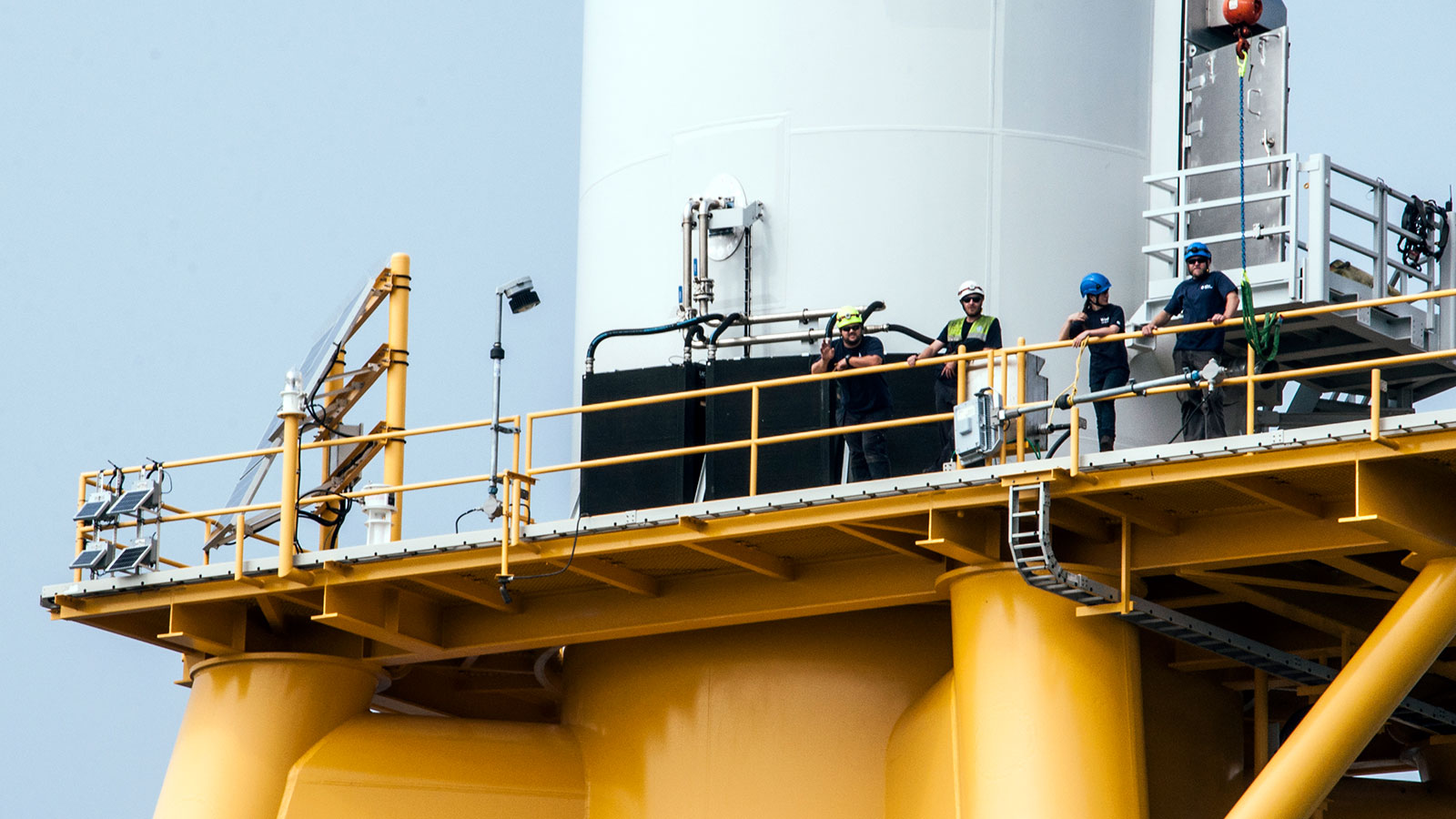
Block Island wind farm techs. Photo: Chris Bentley
Some have described the offshore wind industry in the United States as in “startup phase.” What do you think the next 10-20 years could look like for the sector?
Laura Morton, American Clean Power: Let’s go back to the 30-gigawatt target that the Administration has set. To meet this target, we need to move forward on the projects currently pending before BOEM for permitting. BOEM is looking to complete the environmental review for what they anticipate will be 16 projects by 2025. We also need to see new lease sales in 2021. Eventually, we’re going to see projects up and down the Atlantic coast, including the Carolinas and the Gulf of Maine, and in California.
Building 30 gigawatts of offshore wind energy over the next decade could power 11 million homes, create 80,000 new jobs, and attract USD 57 billion of investment in the U.S. economy. Well-paying jobs have already been created by companies seeking these lease areas, so we are already seeing some of these benefits on the ground.
Building 30 gigawatts of offshore wind energy over the next decade could power 11 million homes, create 80,000 new jobs, and attract USD 57 billion of investment in the U.S. economy.
Among ocean-based measures, offshore wind represents the single largest opportunity for mitigating carbon. As an environmental organization, how does your team balance our global need to drastically reduce emissions with potential concerns around the impacts of offshore wind on marine habitats and species?
Catherine Bowes, National Wildlife Federation: The National Wildlife Federation (NWF) strongly believes that climate change is an existential threat facing people and wildlife around the globe and certainly in the ocean. Our coastal and marine wildlife are already impacted by climate change and a range of other pressures—underscoring the need for strong environmental protections to guide America’s pursuit of wind energy in our oceans. Offshore wind power offers an unmatched opportunity to meet our climate and clean energy goals, particularly along densely populated coastlines in the United States.
We must ensure that offshore wind power can rise to its full potential as a game-changing climate solution—and to do this, all development activities must be done responsibly. This includes strong science-based environmental protection measures every step of the way, from siting and construction to operations and maintenance and eventual decommissioning of a project. We are confident that with strong science-based protections in place—informed by experts and robust stakeholder engagement—offshore wind power can be developed responsibly in the United States in a way that protects and benefits both people and wildlife.
We must ensure that offshore wind power can rise to its full potential as a game-changing climate solution—and to do this, all development activities must be done responsibly. This includes strong science-based environmental protection measures every step of the way.
What are the most promising ways and/or best practices to assess and mitigate potential environmental impacts of offshore wind?
Catherine Bowes, National Wildlife Federation: There are two key stages in the offshore wind development process for implementing best practices: first, where the projects are sited, and secondly, how projects are built and operated in those locations. For both categories, there are opportunities to protect marine species and habitats every step of the way from the planning thru development and operation of wind projects.
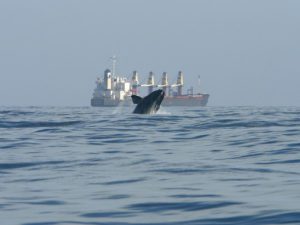
A right whale breaches against the backdrop of a ship in the Atlantic Ocean. Photo: Florida Fish and Wildlife Conservation Commission, NOAA Research Permit #775-1600-10
There are some places in the ocean that are appropriate for offshore wind development and others that are not. Within areas suitable for development, we need to apply strong science-based environmental reviews to understand potential impacts and ways to mitigate them. In the case of whales, reducing risks of exposure to underwater noise and ship collisions are key strategies for minimizing impacts. Another best practice, particularly for minimizing impacts to birds, is to locate projects further offshore given the importance of the sensitive coastal zone for migratory and resident wildlife populations. Avoiding planning certain development activities for times of highest risk to our most vulnerable marine wildlife is a key step, as well as actively monitoring in real-time to ensure the construction areas and transit routes are clear.
Looking forward, among the things that I’m most excited to see is how new and emerging technologies can help minimize potential environmental impacts from offshore wind development activities. For instance, there are ways to install turbines without generating significant underwater noise, including via gravity foundation options. I’m optimistic that America’s offshore wind market—guided by the strong recent announcements from the Biden administration to ensure our new national offshore wind goal is met while protecting biodiversity—will spur innovation in technologies that will solve for a range of challenges currently facing this industry.
Another best practice, particularly for minimizing impacts to birds, is to locate projects further offshore given the importance of the sensitive coastal zone for migratory and resident wildlife populations.
Are there actionable opportunities for the marine conservation NGO and funding communities to support government and industry in scientifically-driven development of the offshore wind sector?
Catherine Bowes, National Wildlife Federation: It was so exciting to see President Biden name offshore wind a key strategy for confronting the climate crisis, as well as part of the plan to “Build Back Better.” It was especially refreshing to see the Administration frame offshore wind through the lens of responsible development that must consider community and wildlife impacts, cultural resources, and ocean uses. To achieve this, we need an engaged and informed NGO community to review the various proposals and provide science-based recommendations to industry and regulators for ensuring responsible development of this critical new clean energy source.
NWF started our offshore wind program 10 years ago, recognizing the important role this energy source must play in solving the climate crisis. The field has accomplished so much progress during this time, particularly around state market policies and advancements in the federal offshore wind leasing on the East Coast, and the momentum is undeniable.
We’re now transitioning into a new phase where this industry is finally becoming real here, and the permitting processes ahead present a range of forums where conflicts and opposition could delay projects. This moment brings a new urgency for broader stakeholder engagement. If we want to see offshore wind be successful and developed responsibly, it’s on us as stakeholders to ensure there are many voices at the table as early in the process as possible to inform and shape the trajectory of this industry and ensure it becomes a responsible, equitable climate solution.
If we want to see offshore wind be successful and developed responsibly, it’s on us as stakeholders to ensure there are many voices at the table as early in the process as possible to inform and shape the trajectory of this industry and ensure it becomes a responsible, equitable climate solution.

